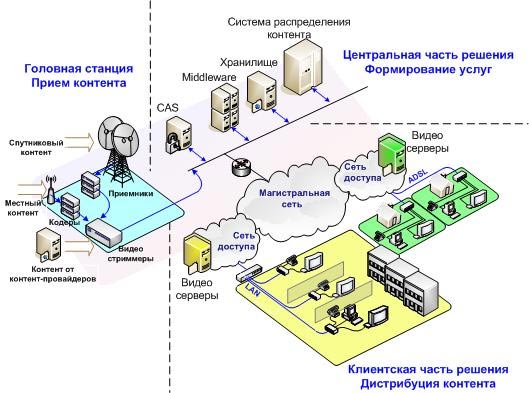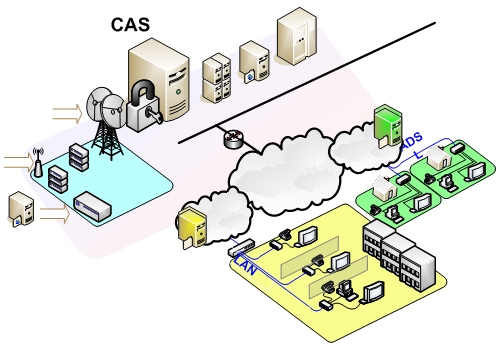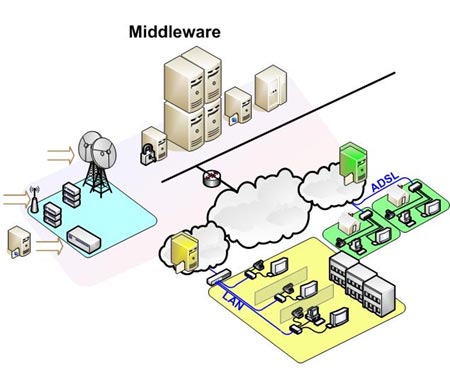Abstract
Contents
- Introduction
- Aims and Tasks
- 1. Review of existing systems for the provision of IPTV services
- 2. Description of the research object
- Conclusions
- References
Introduction
The huge spread of network technologies has stimulated the development of broadband networks and various media applications. In fact, all network has already become a reality
. The purpose of modern networks is to transmit information to users as quickly and as qualitatively as possible. In this regard, specialists began to look for ways to expand the range of services provided. VoIP technology made it possible to use the network to transmit voice data. The next step was the transfer of video for an even more complete use of network communication capabilities. Strong examples of these achievements are IPTV or Television over Internet Protocol (IP-TV, IP-TV) (this is the technology of digital TV in data networks over the protocol). Recently, it is often confused with OTT technology (that is, the transfer of content from the provider to the user without a carrier), which in turn is a subclass of IPTV in the field of video content distribution. In addition, do not be confused with the Internet TV, which is transmitted streaming video and is available to the user directly, without intermediaries (operator companies).
Aims and Tasks
The purpose is to optimize the transmission of IPTV traffic in the provider's network without loss of quality and speed (or with the increase in these figures), taking into account the cost characteristics of the equipment of the network itself and the end devices of users.
Tasks:
– to investigate development trends, principles and options for providing IPTV services to users of relevant services;
– choose the real part of the network and conduct for it the analysis of IPTV traffic, identify the problems that arise when transmitting media streams
– to study modern perspective methods of optimizing the characteristics of access networks, taking into account the transmission of media streams over them to a large number of users;
– to develop a mathematical model for the transmission of IPTV traffic in the network of an Internet provider;
– optimize the provider's network in order to improve the quality of the transmission of IPTV traffic;
– check the quality of the proposed solutions by modeling;
– justify the economic efficiency obtained when implementing the proposed solutions.
Research object: the access network of the Internet provider and media services for the conditions of a large metropolitan area.
The subject of the research: control the transmission of IPTV media streams, taking into account traffic quality metrics and cost characteristics of network and user equipment.
As a result of the development of a subsystem controlling the transfer of IPTV media streams, the following scientific results are planned:
1. Development of a model for the transmission of IPTV traffic in the access network of the Internet provider and media services;
2. Develop an approach for optimizing IPTV traffic in the access network of the Internet provider and media services.
1. Review of existing systems for the provision of IPTV services
The architecture of the network with the provision of IPTV services is shown in Fig. 1.1. Head Station
.

Figure 1.1 – The architecture of the network with the provision of IPTV services
The headend is an important component of the "IPTV" solution when building digital television services. The headend is a software and hardware complex that provides reception of a signal from radio and television stations and satellites, provides decoding and demultiplexing of digital signals and MPEG-coding of analog signals, and then multiplexing the prepared materials into IP streams [1].
Content Closure System. The Content Protection System from Unauthorized Access (CAS / DRM) provides security services and protects video content from unauthorized viewing and digital copying (copyright compliance).

Figure 1.2 – CAS/DRM
The system CAS / DRM (figure 1.2) provides encryption of audio and video materials, while access to materials for subscribers is authorized by subscriber authorization using CAS / DRM systems – middleware , billing . As authorization tools, software keys and the most modern and reliable algorithms are used. Decoding of audio and video materials is carried out directly on the subscriber's side via STB .
Middleware (Figure 1.3).
Middleware is a software hardware complex that provides management of all the components of the IPTV solution, processes requests from subscriber devices, and provides interaction with the systems of the Communications Operator.

Figure 1.3 – Middleware
Middleware has an open architecture that allows you to quickly scale the components of the solution, and expand the range of services. The programmable subscriber interface allows to fully take into account the needs of communication operators and their subscribers.
Subscriber device
The subscriber unit is the link between the systems for the formation and delivery of audio and video materials and the subscriber's TV. The STB device is a minicomputer with an operating system and a WEB browser.
Exchange of control commands and media materials is carried out through a network interface.
Content Distribution System
When building IPTV services, it is not advisable to focus audio and video materials in a single point of exchange. This step leads to increased network load, inefficient use of solution components, and inability to provide high-quality services to a large number of subscribers.
As a result, it is necessary to distribute video servers in the Customer's network qualitatively, so that conditions are ensured:
- minimum load of the customer's network infrastructure;
- Uniform distribution of load on video servers.
To solve this problem, the content distribution system is used.
The distribution system receives requests for access to content from middleware, determines which server with the minimum load and the required data is in the closest proximity to the subscriber, and allows the subscriber to receive them from the selected server. If the server of the required content is not found on the minimally loaded but as close as possible to the subscriber, then the request will be forwarded to another server similar in terms of conditions.
Video Server
Video servers are used to implement NVoD, VoD, PVR services. The video server is a large-capacity disk array with installed software.
The software implements multicast-broadcasting of video materials for NVoD and unicast – broadcasts when providing VoD services. The video server allows to intercept and record multicast streams, that is, to support the PVR service.
Methods of traffic transmission in IP-networks: unicast , broadcast and multicast :
To implement video transmission, you must use the transport layer protocol – TCP. The TCP protocol is used in cases where reliable delivery of messages is required. It frees application processes from having to use timeouts and retransmissions to ensure reliability. But in spite of this protocol is not suitable for use in real-time transmission. This task is solved by the real-time protocol – RTP (Real-Time Transport Protocol) , which guarantees data transmission to one or more destinations with a delay within the specified limits, data can be played in real time. The RTP packets contain the following fields: the sender ID (which of the participants is generating the data), the time stamp of the packet generation (so that the data can be reproduced by the receiving party at the correct intervals), information on the transmission order, and information about the nature of the packet's contents. The presence of such information makes it possible to estimate the amount of the initial delay and the volume of the transmission buffer. The RTP protocol is used only to transfer user data to all session participants. Together with RTP, RTCP (Real-time Transport Control Protocol) protocol works, the main task of which is to provide control over RTP transmission. RTCP uses the same basic transport protocol as RTP, but a different port number.
- The main functions of RTCP:
- providing quality of service and feedback,
- user authentication,
- estimating session sizes and scaling.
2. Description of the research object
The source and destination of streaming multicast traffic will be implemented via VLC mediaplayer (hereinafter VLC player) [6–7].
There is also a multicast transmission problem.
First of all it is important to know that communication operators often deliberately filter through multicast transmission through their networks. Therefore, if you plan to transfer video streams through leased channels or any segments of your own network do not support multicast, you can resort to various methods to get around this problem.
The easiest way is to create a tunnel between network segments. In this case, multicast will be further encapsulated and transferred as ordinary unicast packets. There are a large number of tunneling protocols, each of which has its pros and cons.
Another way is to use broadcast gateways. This method also implies the use of unicast, but in this case (unlike the tunnel), the header of the packets changes. In the simplest case, such a functional can be implemented by installing a pair of servers using an ACL (for example, VLC). But there is also a large number of solutions for IPTV operators, in which the server not only acts as a gateway, but also functions to store and monitor video streams.
Conclusions
When doing master's work, various methods for improving the performance of IPTV networks are considered. Some of these methods have been analyzed. The architecture of the network, the protocols of traffic transmission, the ways of traffic transmission and the problems of traffic transmission are explored. When writing this essay, the master's work is not yet complete. The expected results are an improvement in the quality of the transmission of the services provided, with less money spent on network equipment.
When writing this essay, the master's work is not yet complete. Final completion: July 2018.
Full text of the work and materials on the topic can be obtained from the author or his supervisor after the specified date.
References
- Аль-Днебат Саид Али. Применение сетей массового обслуживания для исследования процессов передачи видеопотоков в пакетных сетях / Научная библиотека диссертаций и авторефератов disserCat. [Электронный ресурс]. – Режим доступа: http://www.dissercat.com/....
- Алексеев И. Интегрированные услуги нового поколения Internet / Игорь Алексеев. [Электронный ресурс]. – Режим доступа: https://www.osp.ru/....
- Мизин И. Телекоммуникационные технологии. Состояние и перспективы развития / И. Мизин. – М.: Электроника НТБ. Выпуск #1 / 1998.
- Анатомия VoD – основы
видео по запросу
[Электронный ресурс]. – Режим доступа: http://internetno.net/.... - Бугай А. А. IPTV Вызов традиционному телевидению / Бугай А. А., Яшенкова Н. А. // T-Comm. 2008. № 1. [Электронный ресурс]. – Режим доступа: http://cyberleninka.ru/article/... (дата обращения: 23.01.2018).
- Петрусь И. П. Аспекты практического использования беспроводной оптической технологии передачи данных / Петрусь Иван Павлович, Гузенкова Елена Алексеевна // Интернет-журнал Науковедение. 2014. № 2 (21). [Электронный ресурс]. – Режим доступа: http://cyberleninka.ru/article/... (дата обращения: 23.01.2018).
- Шалагинов В. А. Требования к построению транспортных сетей операторов мобильной связи // T-Comm. 2012. № 7. – С. 225–227.
